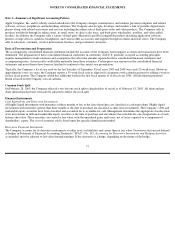Apple 2006 Annual Report Download - page 81
Download and view the complete annual report
Please find page 81 of the 2006 Apple annual report below. You can navigate through the pages in the report by either clicking on the pages listed below, or by using the keyword search tool below to find specific information within the annual report.
NOTES TO CONSOLIDATED FINANCIAL STATEMENTS (Continued)
Note 1—Summary of Significant Accounting Policies (Continued)
included in “accumulated other comprehensive income” in shareholders’ equity. The Company’s foreign manufacturing subsidiaries and
certain other international subsidiaries that use the U.S. dollar as their functional currency remeasure monetary assets and liabilities at exchange
rates in effect at the end of each period, and inventories, property, and nonmonetary assets and liabilities at historical rates. Gains and losses
from these translations were insignificant and have been included in the Company’s results of operations.
Revenue Recognition
Net sales consist primarily of revenue from the sale of hardware, software, peripherals, digital content, and service and
support contracts. The
Company recognizes revenue pursuant to applicable accounting standards, including American Institute of Certified Public Accountants
Statement of Position (“SOP”) No. 97-2, Software Revenue Recognition , as amended, and Securities and Exchange Commission (“SEC”)
Staff
Accounting Bulletin (“SAB”) No. 104, Revenue Recognition .
The Company recognizes revenue when persuasive evidence of an arrangement exists, delivery has occurred, the sales price is fixed or
determinable, and collection is probable. Product is considered delivered to the customer once it has been shipped and title and risk of loss have
been transferred. For most of the Company’s product sales, these criteria are met at the time the product is shipped. For online sales to
individuals, for some sales to education customers in the U.S., and for certain other sales, the Company defers revenue until the customer
receives the product because the Company legally retains a portion of the risk of loss on these sales during transit. If at the outset of an
arrangement the Company determines the arrangement fee is not, or is presumed not to be, fixed or determinable, revenue is deferred and
subsequently recognized as amounts become due and payable.
Revenue from service and support contracts is deferred and recognized ratably over the service coverage periods. These contracts typically
include extended phone support, repair services, web-based support resources, diagnostic tools, and extend the service coverage offered under
the Company’s one-year limited warranty.
The Company sells software and peripheral products obtained from other companies. The Company establishes its own pricing and retains
related inventory risk, is the primary obligor in sales transactions with its customers, and assumes the credit risk for amounts billed to its
customers. Accordingly, the Company recognizes revenue for the sale of products obtained from other companies based on the gross amount
billed.
Revenue on arrangements that include multiple elements such as hardware, software, and services is allocated to each element based on the
relative fair value of each element. Each element’s allocated revenue is recognized when revenue recognition criteria for that element have
been met. Fair value is generally determined by vendor specific objective evidence (“VSOE”), which is based on the price charged when each
element is sold separately. If the Company cannot objectively determine the fair value of any undelivered element included in a multiple-
element arrangement, the Company defers revenue until all elements are delivered and services have been performed, or until fair value can
objectively be determined for any remaining undelivered elements. When the fair value of a delivered element has not been established, the
Company uses the residual method to recognize revenue if the fair value of all undelivered elements is determinable. Under the residual
method, the fair value of the undelivered elements is deferred and the remaining portion of the arrangement fee is allocated to the delivered
elements and is recognized as revenue.
80
























